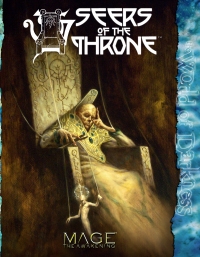
| This is a Seers of the Throne Only Legacy
|
The unspoken word is the Lord upon which all else depends.
The Seers of the Throne have one great taboo: do not invoke the Gate. She is the Lonely Exarch at the borders of existence. He watches the Abyss, and in watching it, gives it form and power. She opened a terrible, necessary door to envelop the Fallen World in a spiritual desert: a cloak of madness that bars the Supernal Realms to all but a few powerful, eccentric wills.
That’s the taboo. Like all taboos, people break it from time to time. Seers disobey, search and usually don’t find anything. Sometimes, they’re caught and punished. A few become Scelesti, and claim to serve the Gate. That’s a lie — they’re only slaves of the Abyss.
A few succeed. They find the Lonely Exarch. They join a Legacy that’s had many names over the centuries. The Secret Order of the Gate is its latest incarnation, founded over 100 years ago by a pylon that lost three Soldiers to the Pentacle (especially Nameless mages who joined the Free Council) and two more to treachery — rivals who hit them when they were down. That sowed the seeds of doubt, fueled the quest for power beyond the accepted Iron Seals. In 1901, the last three found the Gate in Chicago. Some say they used an Artifact called the Celestial Flange to call her from the Place Between.
So began the Secret Order and its mission. It is the demi- Ministry of the Gate, the Warder, The Fearful Reconciler, King of Zero. They love him. They worship her utterly. That slowly, invariably drives them mad.
The Secret Order’s inner doctrine speaks of the Serpent and the Tree. The Tree is the Fallen World, growing from filth up to the Supernal Sky. The Celestial Ladder was inevitable; the Tree always climbs, using the smaller life within in to manifest that fecund desire. If it ever grew too tall, it would envelop the heavens in its unclean tendrils and choke existence to death.
It must be pruned, dismembered and hurt from time to time. The Exarchs did it when they cut down the Celestial Ladder, and the Gate does it still, with the blackest, sharpest blade of all: the Abyss. That’s the anti-reality’s purpose. It’s the Serpent, Niddhog gnawing at the World Tree — but it too must be restrained. The Serpent and the Tree live in symbiosis. Unbeing seeks being, and devours it. Being fills the void until it’s either stopped, or suffocates.
That’s why the Secret Order of the Gate calls Abyssal horrors into the world, and why it banishes them when they stay too long or eats too deeply into the Tree’s heartwood.
They let the Serpent prune the world in small pulses of destruction, designed for symbolic import. Killing a city is excessive; killing the man who represents the city is good enough, and the manner of his ending is the rite that controls that symbolic power. So the world is left a smaller place — Fallen, but alive — without raising poisoned branches to the heavens.
The Secret Order believes in two paths of service: the Opening Way and the Warding Way. Openers summon Abyssal manifestations; Warders banish them. The perfect Gatekeeper performs both duties, but few can maintain the balance. They see too much. Their minds break in one direction or the other and they pick a side. The Gatekeepers call themselves the truest Seers of the Throne, and say the Ministries are foolish for denying it, and leaving the Lonely Exarch in exile.
Attainments
- Shroud of the Borderland
- Walk the Place Between
- Dwell in the Place Between

